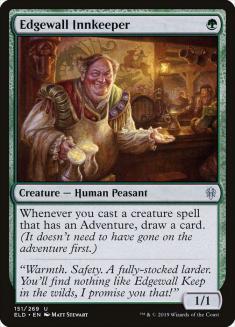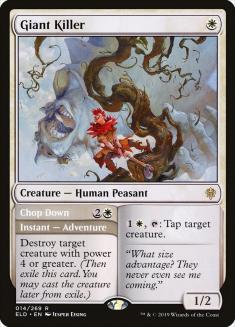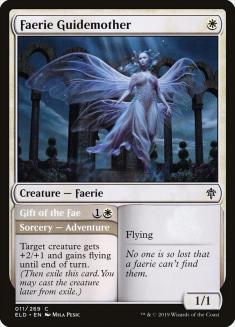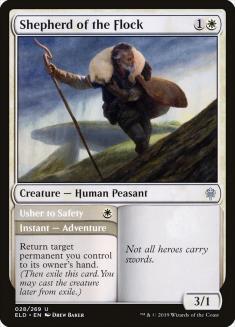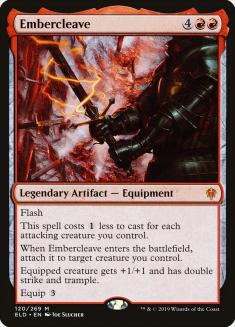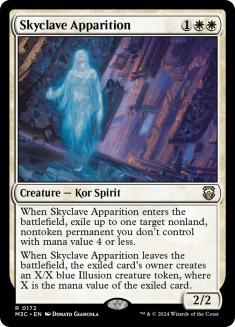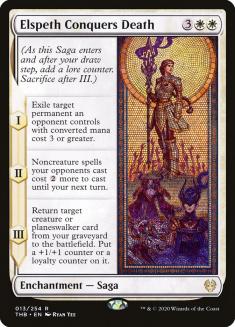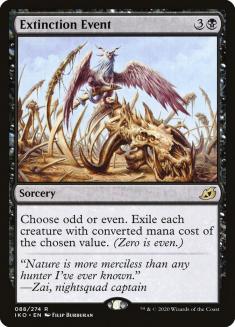The question going into last weekend’s Zendikar Rising League Weekend splits was whether or not Yorion, Sky Nomad would continue its domination of the Standard metagame. And I am happy to say that the answer to that question was a resounding no. Between Dimir Rogues decks that continue to move more and more in a controlling direction, the return of Gruul Adventures, and Temur Ramp, strategies all across the spectrum were able to succeed against the powerful Bird Serpent. It would appear that Yorion decks are merely one of many viable options in a diverse, fun Standard format.
Yes, I just used the words “diverse” and “fun” to describe Standard. You’re not dreaming. This is the real world. Just take some deep breaths and you’ll be fine.
Moving forward, you can pick up any of the decks I mentioned above and climb the Arena ladder just fine. They’re all powerful options and can be tuned appropriately as the metagame evolves. But I think this Standard format has even more to offer. When I was going over the lists from last weekend, the one that stood out to me was from Rivals League member Kenji Egashira, though you may know him better as NumotTheNummy on Twitch. He brought a Selesnya Adventures deck to an impressive 8-3 record:
Creatures (31)
- 2 Scavenging Ooze
- 4 Lovestruck Beast
- 3 Faerie Guidemother
- 2 Questing Beast
- 4 Giant Killer
- 4 Edgewall Innkeeper
- 4 Shepherd of the Flock
- 4 Skyclave Apparition
- 4 Kazandu Mammoth
Planeswalkers (2)
Lands (19)
Spells (8)

In a field as stacked as the Rivals League, 8-3 is an impressive record, and after playing with the deck myself, I’m not surprised. Gruul and Golgari may have the pedigree when it comes to aggressive Adventures strategies, but Selesnya has the best tools now. And this isn’t the Selesnya Adventures deck of old that was all-in on one-drops and Venerated Loxodon. This deck is more akin to the Golgari deck, which is just as capable of winning through attrition as it is through aggression.
I much prefer aggro decks that can play into the late-game since it puts a lot less pressure on your opening hand to create a significant advantage and ensures that decks with lots of cheap removal or sweepers are more than manageable.
Let’s look at what makes Selesnya Adventures so well-positioned:
Edgewall Innkeeper Is by Far the Best One-Drop in Standard
I’m leading with the least controversial take. The biggest issue facing aggressive strategies in Standard right now is the lack of quality one-mana plays. You need a certain density of those creatures to make a low-to-the-ground aggro deck work, and it just isn’t there. That’s part of the reason we’ve seen midrange-aggressive decks more often this season. And in those decks, you want your early plays to demand an answer early so your more powerful threats stick or have utility even when the game goes long.
Edgewall Innkeeper accomplishes both of these things. So at this point I’m skeptical of any aggressive strategy that isn’t centered around the smiling suds-slinger himself. Believe me, I’ve tried just about all of them. And as much as I want to activate Whisper Squad ad infinitum, it’s not strong enough.
So it should follow that if you want to be aggressive in Zendikar Rising Standard, you should be looking to play the best Edgewall Innkeeper deck possible. And Selesnya Adventures maximizes the card’s potential more often than Golgari or Gruul. It has more playable Adventure creatures than Gruul, and cheaper Adventure creatures than Golgari, which may not seem like a big deal, but it is.
As powerful as Edgewall Innkeeper is, it has a huge target on its back every time it enters the battlefield. And it dies to nearly every removal spell in the format, so most of the time your window to extract value from the card is very short. Having cheap Adventure creatures lets you set up a turn where you cast one immediately after the Innkeeper, thus securing some value. It also means that, should you be fortunate enough to untap with one, you can likely draw one or two cards on your next turn and quickly punish your opponent.
No other Adventures deck has two other one-mana Adventure creatures. And you’re not sacrificing in terms of quality either. Giant Killer is every bit as good as the removal in the other variants — Bonecrusher Giant and Murderous Rider. I wrote about it as a potential breakout card in the post-ban world and I’m still high on it. Faerie Guidemother is the worst creature in the deck, but you need another 1/1 to make Lovestruck Beast reliable and Gift of the Fae can jump a creature for lethal. I’m still waiting to live the dream of targeting my opponent’s creature so it gets big enough to Chop Down.
Last is Shepherd of the Flock, which does so many little things that I’m going to get back to it later. For now, suffice it to say that white offers the best supporting cast for Edgewall Innkeeper. It has the best combination of volume of Adventure creatures, quality of Adventure creatures, and overall curve. With Lovestruck Beast and Kazandu Mammoth as staples of these decks, it’s great to not add too many more three-mana plays and overload that spot on the curve.
White Has the Best Removal
Between Edgewall Innkeeper; The Great Henge; and Vivien, Monsters’ Advocate, green offers plenty of robust card advantage engines. For years in Standard, we’ve seen green card advantage pair up with whatever color offers the best removal to form a winning combination. When you’re out-drawing your opponent, the best way for them to win is to stick a threat that can take over the game by itself. If you find the right removal suite you can cut off this plan of attack.
This is why I’m skeptical of Gruul Adventures moving forward. It wants to play a more aggressive game with less removal and Embercleave. So it doesn’t utilize the card advantage engines as well, and it relies on Embercleave to end games before a permanent it can’t answer takes over. If your opponents are prepared for Embercleave, you don’t have the maneuverability to adjust.
Golgari has been the default option for pairing green card advantage with removal, but right now white’s removal is much better. Black’s removal is designed to answer planeswalkers effectively, and there aren’t many planeswalkers around. A couple of Viviens from the green decks; Ugin, the Spirit Dragon from the ramp decks; and maybe some Liliana, Waker of the Deads in Rakdos are about all you see.
However, there are a lot of graveyard shenanigans between Agadeem’s Awakening, Lurrus of the Dream-Den, Elspeth Conquers Death, and escape creatures. White’s focus on exile effects is a huge boon here for cleanly answering recursive threats and mitigating the effectiveness of the above cards. Black also has a hard time answering artifacts and enchantments, which are plentiful right now. Skyclave Apparition and Elspeth Conquers Death have the versatility to answer cards like Mazemind Tome, Glass Casket, and The Great Henge.
Lastly, every single one of the removal spells in the Selesnya Adventures maindeck represents a two-for-one — Giant Killer and Skyclave Apparition come with bodies attached and Elspeth Conquers Death recurs a threat two turns later.
This card advantage obviously helps your long game, but it’s important for your aggressive games as well. It means that you’re able to answer key threats without sacrificing your own threat density so you can still pressure your opponent. The increased threat density is also very welcome in a The Great Henge deck.
It’s a strange world to live in where an aggressive Selesnya deck has such good removal, but here we are. I suggest you take advantage.
Don’t Underestimate Shepherd of the Flock
I mentioned earlier that aggro decks that are looking to play attrition games somewhat often need to play early creatures that are still relevant late. Scavenging Ooze, a staple of green decks, fits the bill there, but Shepherd of the Flock does as well. Usher to Safety is one of those effects that doesn’t read that well, but the more you play with it, the more ways you find to utilize it. Here’s a partial list of things it can do:
- Protect a key permanent from removal
- Rebuy an Adventure creature to either recast the spell or recast the creature to trigger Innkeeper
- Bounce Skyclave Apparition with the enters-the-battlefield trigger on the stack to stop them from getting an Illusion token
- Rebuy Elspeth Conquers death for another removal spell
- Bounce a DFC to use its other side
- Bounce a planeswalker to recast it for another activation
- Bounce a land so you can trigger landfall on Kazandu Mammoth
I liken Shepherd of the Flock in this deck to Phantasmal Image in Modern Humans. Once you’ve developed a battlefield and you’re looking to close out the game, it’s often your best topdeck, because it either draws a bunch of cards or becomes whatever removal spell you need to punch through your opponent’s defenses. That’s exactly what you want out of a two-mana creature in a deck like this.
Rimrock Knight and Order of Midnight don’t have anywhere close to this level of flexibility, so this is another win for Selesnya. Despite having a lower curve, Selesnya has the best late-game of the Adventures decks, because it has the highest density of good topdecks going long. It’s rare that you run out of things to do with your mana, and while you will look to end the game against control or ramp strategies, you can absolutely win on Turn 10 or later in those matchups. Shepherd is a big part of that.
Weaknesses to Watch Out For
Unfortunately, it’s not all upside for Selesnya. There are two cards that worry me out of this deck relative to the other Adventures strategies. The first is opposing Edgewall Innkeepers, which you can only answer with Skyclave Apparition. This was a huge worry for me at first, and will definitely bite you in some games, but I’ve found that as long as you are able to stop their aggression, you can turn around an early material disadvantage. You’ll still want to answer the Innkeeper quickly, but it drawing an extra card or two isn’t a death sentence for you.
You could utilize something like Glass Casket, but I don’t want to play pure removal spells in this deck. Primal Might, which offers some closing power, or Kabira Takedown as another DFC are better options.
The second problem card is Extinction Event. This deck’s curve is concentrated at one and three, which means Extinction Event is often a discounted Final Judgment. Usher Away helps here, but cards like Selfless Savior and Heroic Intervention are useless. Fortunately, Extinction Event isn’t particularly popular right now, but it slots easily into Dimir Rogues, especially as they lower their own creature count.
You can move away from Faerie Guidemother and play more copies of Scavenging Ooze and Questing Beast, but that’s going to both raise your curve and reduce the effectiveness of the Adventure engine. I’ll be reluctant to do so unless it’s absolutely necessary, so I’ll be closely monitoring the number of Extinction Events in the metagame moving forward.
So far, I’ve only changed two cards from Kenji’s list, swapping the sideboard copy of Questing Beast and the Yasharn, Implacable Earth for a third copy of Oakhame Adversary and a second Primal Might to solidify the matchup against other green decks. It’s a well-built list that should remain under the radar as players focus on the updates to Dimir Rogues, Gruul Adventures, and Temur Ramp as the new top decks.
But if we’ve learned anything from the first weeks of post-ban Zendikar Rising Standard, it’s that the top decks in Standard won’t stay on top for very long. So if you want to stay ahead of the metagame, I’d look no further than Selesnya Adventures, the most underrated deck in Standard.


